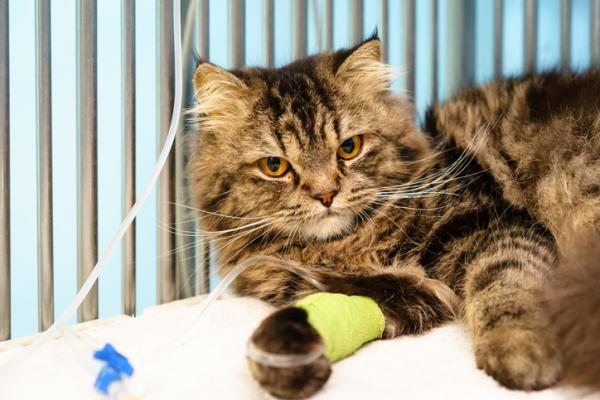
The diaphragm in cats functions in the same way as the human diaphragm. It is a layer of abdominal muscle which contracts to cause the lungs to expand. Doing so helps with respiration as the lungs inhale and exhale air. A cat diaphragm is susceptible to the same pathologies and trauma, although a diaphragmatic hernia is more common in cats than humans. Affected cats will present symptoms which can vary in severity, but it is possible it can cause compression on the lungs and heart which can be very dangerous.
At AnimalWised, we reveal more about diaphragmatic hernia in cats. We look at the causes, symptoms and treatment of feline diaphragmatic hernias so you can know what to expect if your cat is affected by one.
What is a diaphragmatic hernia in cats?
In its most basic description, a diaphragmatic hernia occurs when there is an abnormal hole or opening through which contents of the cat's abdomen escape. These contents are usually in the form of fat tissue, but can include abdominal organs such as the liver, spleen, stomach or intestine. How much escapes depends on the size of the hernia.
The diaphragm is a muscle important for breathing. It causes negative pressure when it contracts, reducing the curvature of the diaphragm and moving back to the center. This increases the volume of the thoracic cavity and allows the lungs to expand for respiration to continue. The diaphragm is located between the thoracic and abdominal cavities, acting as a guard between the two and stopping abdominal organs penetrating the thoracic cavity.
Types of diaphragmatic hernia in cats
Diaphragmatic hernias in cats can be of two main types:
- Traumatic diaphragmatic hernia: after a blow, fall or fight, internal damage can occur, including the rupture of the diaphragm. The result can be a hernia and an opening between the thoracic and abdominal cavities.
- Congenital peritoneum-pericardial diaphragmatic hernia there is a long-lasting opening between the pericardial cavity (layer that surrounds the heart) and the peritoneum (layer that covers the abdominal viscera). It is usually of a congenital origin. This means that cats are born with this hernia, but many of them do not have any symptoms. In symptomatic cases, liver and gallbladder abnormalities are generally observed.

Causes of diaphragmatic hernia in cats
Generally, diaphragmatic hernias present at birth for in kittens are congenital in origin, those that appear after birth are traumatic in origin. In cats, they are more often caused by an accident, such as a fall from a great height, being in a vehicular collision or hitting an object at speed.
It should be considered that the diaphragm in young cats is a fine and still underdeveloped structure. This means it is more frequent and easier to break than adults. It is also possible for the cat to have a congenital diaphragmatic hernia which is small and asymptomatic, but which is widened due to trauma later in life.
Symptoms of diaphragmatic hernia in cats
Cats with diaphragmatic hernia will generally present clinical respiratory signs, ranging from mild respiratory distress to significant respiratory dysfunction. The latter will be accompanied by severe dyspnea (failure to breathe) and lesions. These can cause chest wall dysfunction, presence of air, fluid or viscera in the pleural space, pulmonary edema, cardiovascular dysfunction and shock.
Cats usually present costal breathing (breathing with the lungs), resulting in the chest expanding more than usual and may show distension of the belly. Just over 10% of cats have cardiac arrhythmias. Other clinical signs include:
- Thoracic gurgling noises
- Reduced cardiorespiratory sound
- Vomiting
- Anorexia
- Regurgitation
- Dysphagia
- Jaundice
Jaundice results in the yellowing of mucus membranes and even the cat's skin due to liver failure. This occurs when the liver is herniated. It is important not to confuse the cat's gurgling noises with gastrointestinal activity.
Diagnosis of feline diaphragmatic hernia
Diagnosis is achieved by chest radiography to visualize herniated organs in the thoracic cavity and assess the severity of the hernia. Ultrasound will be used in some cases to differentiate the abdominal organs and chest auscultation to assess the sounds produced.
Generally, a dull percussive sound indicates the spleen and liver have been displaced. When there is fluid in the pleural cavity and if the sound is tympanic, the herniated organs are usually the intestine and stomach.

Treatment for diaphragmatic hernia in cats
Treatment for congenital diaphragmatic hernias depends on whether they produce symptoms. However, if they do require treatment, the only option for both these and traumatic diaphragmatic hernias is reconstructive surgery of the diaphragm.
Surgery and postoperative care of diaphragmatic hernia in cats
To perform this surgical intervention, sedation and general anesthesia is necessary. For traumatic hernias, the effects of the trauma can severely complicate the clinical picture. The first thing will be to stabilize the cat through oxygen therapy, use a thoracotomy to extract any air or fluid in the pleural cavity, and provide any other medical treatment which will help.
The purpose of the surgery is to reconstruct the diaphragm and return the herniated tissue to its normal position within the abdominal cavity. After surgery, the cat will need to be hospitalized for a short time and medicated to control pain and inflammation. Complications in recovery include pneumothorax or lung edema. Generally, cats operated on for diaphragmatic hernia have a high success rate and recovery is relatively fast.
If you want to know more about hernias in cats, take a look at our article on feline umbilical hernia.
This article is purely informative. AnimalWised does not have the authority to prescribe any veterinary treatment or create a diagnosis. We invite you to take your pet to the veterinarian if they are suffering from any condition or pain.
If you want to read similar articles to Diaphragmatic Hernia in Cats - Causes, Symptoms and Treatment, we recommend you visit our Other health problems category.
- Harvey, A., Tasker, S. (eds). (2014). Feline Medicine Manual. Ed. Sastre Molina. L ́Hospitalet de Llobregat.